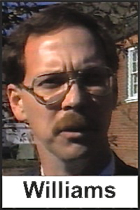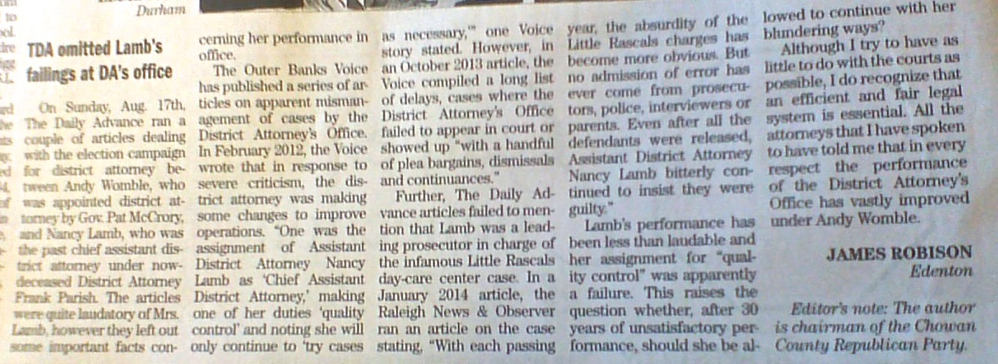Rascals case in brief
In the beginning, in 1989, more than 90 children at the Little Rascals Day Care Center in Edenton, North Carolina, accused a total of 20 adults with 429 instances of sexual abuse over a three-year period. It may have all begun with one parent’s complaint about punishment given her child.
Among the alleged perpetrators: the sheriff and mayor. But prosecutors would charge only Robin Byrum, Darlene Harris, Elizabeth “Betsy” Kelly, Robert “Bob” Kelly, Willard Scott Privott, Shelley Stone and Dawn Wilson – the Edenton 7.
Along with sodomy and beatings, allegations included a baby killed with a handgun, a child being hung upside down from a tree and being set on fire and countless other fantastic incidents involving spaceships, hot air balloons, pirate ships and trained sharks.
By the time prosecutors dropped the last charges in 1997, Little Rascals had become North Carolina’s longest and most costly criminal trial. Prosecutors kept defendants jailed in hopes at least one would turn against their supposed co-conspirators. Remarkably, none did. Another shameful record: Five defendants had to wait longer to face their accusers in court than anyone else in North Carolina history.
Between 1991 and 1997, Ofra Bikel produced three extraordinary episodes on the Little Rascals case for the PBS series “Frontline.” Although “Innocence Lost” did not deter prosecutors, it exposed their tactics and fostered nationwide skepticism and dismay.
With each passing year, the absurdity of the Little Rascals charges has become more obvious. But no admission of error has ever come from prosecutors, police, interviewers or parents. This site is devoted to the issues raised by this case.
On Facebook
Click for earlier Facebook posts archived on this site
Click to go to
Today’s random selection from the Little Rascals Day Care archives….
Click for earlier Facebook posts archived on this site
Click to go to
Today’s random selection from the Little Rascals Day Care archives….
Oh, for the ability to recognize something ‘odd’
 June 25, 2012
June 25, 2012
“I saw this woman in her 20s … accused of something like 2,800 charges of child sex abuse. Oh, I thought, well, that’s very odd….
“I thought, How can (Kelly Michaels) one woman, one young, lone woman in an absolutely open place like the child care center of the church in New Jersey that she worked for – how could she have committed these enormous crimes against 20 children, dressed and undressed them and sent – you know what it is to dress and undress even one child every day without getting their socks lost? – 20 children in a perfectly public place, torture them for two years, frighten and terrorize them, and they never went home and told their parents anything?… This did seem strange.”
– Dorothy Rabinowitz, recalling on C-SPAN the 1985 case that led to her Pulitzer-winning coverage of the ritual-abuse day-care mania
“This did seem strange.”
From the vantage of 2012, of course, such allegations seem not only “strange” but also patently incredible.
So why didn’t everybody – therapists, journalists, prosecutors, jurors – share Rabinowitz’s reasonable doubt?
How did such a grotesque misconception flourish?
Had skepticism really fallen that far out of fashion during the “Believe the Children” zeitgeist?
Imagining my part of a chat with H.P. Williams Jr.
Dec. 9, 2011
 Had former district attorney H.P. Williams Jr. let our conversation drag on beyond 30 seconds on Wednesday, here are some questions I might have asked:
Had former district attorney H.P. Williams Jr. let our conversation drag on beyond 30 seconds on Wednesday, here are some questions I might have asked:
– In all the day care cases of the ʼ80s and early ʼ90s – Little Rascals, McMartin, Fells Acres, Wee Care, ad nauseam – why was not one instance of sexual abuse ever witnessed by an adult?
– Why was not one piece of physical or medical evidence ever presented?
– Would you still argue at Bob Kellyʼs sentencing hearing that “There is no reason he should be restored to the community at any time”?
– Have you been surprised that, since being freed, not one of the defendants has returned to a life of serial child sexual abuse?
– What would it take for you to admit the Edenton Seven were innocent?
● ● ●
If H.P. Williams Jr. – or any other reader – would like to respond, he is always welcome to do so here.
Evidence of new day in Edenton? We can hope

Elizabeth City Advance, Sept. 6, 2014
Sept. 17, 2014
I’m doubly intrigued by this recent letter to the editor of the Elizabeth City Advance.
First, that an electioneering party official – in Edenton! – would cite the Little Rascals prosecution as an “infamous” example of Nancy Lamb’s failures.
Second, that 10 days after publication not a single correspondent has taken to the pages of the Advance to challenge the point!
Will no one today step forward to justify the state’s longest and costliest trial? To swear continuing allegiance to the credo of “Believe the Children”? To once again praise unreservedly the eight-year crusade Nancy Lamb waged against Bob Kelly?
It’s almost enough to make me think rationality has reclaimed the public mind in Edenton. If so, it took its own sweet time.
Double-decker graves, portable crematoriums… and so on
Feb. 22, 2013
“The argument for an organized network of satanists is virtually irrefutable. Ritual abuse survivors’ reports contain many fantastic elements. Rather than regard the implausible features of these accounts as grounds for skepticism, however, proponents of the satanic conspiracy theory insist that it is precisely these elements than mean the stories must be true. No one, they insist, would or could make up such bizarre, macabre stories.
“Sometimes proponents retreat to the position that satanists commit bizarre activities precisely so that victims will not be believed when they recount their experiences. This latter tack illustrates the problem of infinite regress (a sequence of reasoning or justification that can never come to an end).
“When confronted with the difficulty of concealing so many homicides, proponents explain that satanists dispose of bodies… in double-decker graves. Challenges to this argument lead to assertions that bodies are burned. The observation that bodies cannot be burned in ordinary fires leads to the assertion that they are cremated. The problems of gaining access to crematoriums lead to contentions that satanists use special portable crematoriums. Further protestation may yield the argument that child-witnesses may be mistaken about some deaths because satanists sometimes use life-like dolls rather than live humans to terrorize children into silence.
“The continual retreat from the lack of confirming evidence shifts the burden of proof from those seeking to demonstrate a satanist network to those questioning such assertions.”
– From “The Satanism Scare,” edited by David G. Bromley (1991)











0 CommentsComment on Facebook